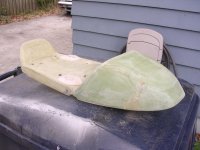RoyalRider
2010 Royal Enfield Bullet 500 - 1982 Honda CB125s
Hello people,
Thanks for taking the time to read my post. I have an '82 Honda CB125S that I am working on as a project and am currently trying to fabricate fibreglass parts for it. I've already made a great fender but I'm struggling with the seat.
I'm 25 now but when I was 16-17 I did some fibreglass work on boats for the sailing club I worked at. Not much experience other than that so I'm pretty much useless when it comes to bodywork.
Here is how my seat looks like now :
http://imgur.com/a/h1I4Y (please let me know if you have trouble viewing this I can always attach it to the post or re-upload with a different website)
As you can tell, it is mostly filler... here is what it looked like when it was just glass: http://imgur.com/8mMQKbY. Full of imperfections and a few holes, this pic was taken after I rough sanded off bubbles and stuff before applying 3M bondo.
What would you guys do in my position? Please note that I am recently graduated but with a job...meaning that I am not poor but can't afford to just throw money at it or bring it to a professional shop.
I'm thinking the best course of action is to somehow use the inside of it as a mold. I've never done anything like this so right now my best guess is this and you guys can tell me if it is stupid :
I was thinking of using balsa wood to line the inside and then remove it and nail it together to create another 3D shape with perfectly flat surfaces. Then I just re-do what I did originally to the insulation foam I used which is to tape it, wax it, and glass it using fibreglass cloth as opposed to mat (which is what the seat above was made out of).
Thanks for any and all advice.
Thanks for taking the time to read my post. I have an '82 Honda CB125S that I am working on as a project and am currently trying to fabricate fibreglass parts for it. I've already made a great fender but I'm struggling with the seat.
I'm 25 now but when I was 16-17 I did some fibreglass work on boats for the sailing club I worked at. Not much experience other than that so I'm pretty much useless when it comes to bodywork.
Here is how my seat looks like now :
http://imgur.com/a/h1I4Y (please let me know if you have trouble viewing this I can always attach it to the post or re-upload with a different website)
As you can tell, it is mostly filler... here is what it looked like when it was just glass: http://imgur.com/8mMQKbY. Full of imperfections and a few holes, this pic was taken after I rough sanded off bubbles and stuff before applying 3M bondo.
What would you guys do in my position? Please note that I am recently graduated but with a job...meaning that I am not poor but can't afford to just throw money at it or bring it to a professional shop.
I'm thinking the best course of action is to somehow use the inside of it as a mold. I've never done anything like this so right now my best guess is this and you guys can tell me if it is stupid :
I was thinking of using balsa wood to line the inside and then remove it and nail it together to create another 3D shape with perfectly flat surfaces. Then I just re-do what I did originally to the insulation foam I used which is to tape it, wax it, and glass it using fibreglass cloth as opposed to mat (which is what the seat above was made out of).
Thanks for any and all advice.



 ) but would take 30-40 minutes to harden. Also just as a side note you can mix bondo and the fiber glass gel (different ratios to make it more fluid or not) with the fiber glass hardner to get a super hard bondo that is more resistant to cracking then normal bondo but it is harder then hell to sand so work with it when it is still softish.
) but would take 30-40 minutes to harden. Also just as a side note you can mix bondo and the fiber glass gel (different ratios to make it more fluid or not) with the fiber glass hardner to get a super hard bondo that is more resistant to cracking then normal bondo but it is harder then hell to sand so work with it when it is still softish. 

